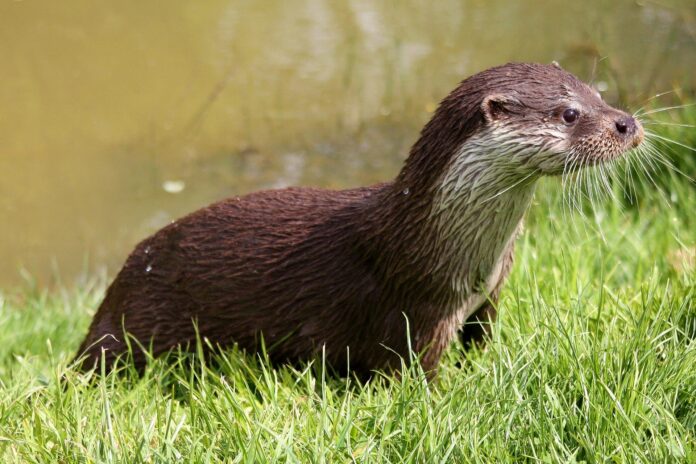How to pet a otter. Most people really don’t know about otters. So today i decide to give a lesson about them. Otters must constantly brush their fur to maintain its insulating properties. Otters spend a lot of time grooming themselves, and many species of river otters have dedicated areas on land where they can dry and groom their fur. Most are vigorously dried by rolling on the ground or rubbing logs or vegetation. Researchers have noticed that sea otters spend at least 11-48% of their day grooming themselves. They use their paws and claws to remove debris and groom themselves. They can also aerate their fur by blowing air into it and tapping the water with their feet to turn it into foam. The otter’s flexible body and thick fur allow it to reach every part of its fur.
How to pet an otter – sprain
River otter litter, commonly referred to as sprinting by otter researchers, is extremely important for otter communication. Stretching is a visual and olfactory indicator of the presence of an otter. Otters make small sprints several times a day, laying them in specially designated prominent areas and spraying them with scent.
Play
Some researchers believe that sledding is a form of play for the river otter. Gliding otters of all ages have been observed in some species. Others believe that otters only use these slides for low-energy rides, stating that otters don’t usually climb to the top of the slope for another slide. These latter researchers observed very little behavior that they interpreted as gambling.
How to pet an otter – sleep
Freshwater otters usually rest and sleep on land, either on the ground or in burrows. They are not picky about where they sleep and often do so even in areas of moderate disturbance. Individual animals often have multiple resting places. Sea otters sleep in the sea, floating on their backs on the surface. They often sleep on strands of algae that keep them from drifting.
How to pet an otter – social structure
Most male and female river otters form separate domain hierarchies. Males with the best rankings occupy the most favorable ranks. Males and females usually tolerate each other, but do not form a company. A female with cubs can become dominant over a male. In Southeast Asia, smooth otters are commonly found in social groups consisting of a pair of adult males and females and their young. Spotted otters have been observed in groups of 6 to 20 individuals. In Lake Victoria in East Africa, spotted-necked otters can go through aggregation and dispersal cycles, with males and females forming distinct groups. A group of females can contain 8 to 20 individuals, but becomes smaller during mating when females mate with males. A giant otter social group consists of a pair of adults, one or more juveniles, and one or more juveniles.
Groups of up to 20 have been reported, but groups of 4 to 8 are more common. Giant otters display a high degree of pair bonding and group cohesion. Cape clawless otters have a clan social organization, when groups of related animals unite with each other and protect common territories. Males can maintain free communication with the female and her cubs. Asian clawed otters live in small family groups of about 12 individuals.
Sea otters are mostly solitary, but in Alaska they gather in large groups of up to 2,000 individuals. Males and females occupy separate areas of the coastline, only briefly gathering together for mating.
Social and territorial behavior
River otters tend to be solitary and quite territorial. Avoidance is a very important factor in the river otter’s social behavior. River otters defend their territories by marking, scratching, and sometimes fighting. Male river otters ignore females and pups for most of the year. Giant otters are more sociable than river otters, but individual groups tend to avoid each other.
How to pet an otter – Clawless otters are relatively sociable.
Male sea otters settle in female-only territories and attempt to mate with any female that enters their territory. However, they do not represent a competition.
What do otters eat?
In the wild, most species of otters feed on fish and shellfish, river otters feed on prey such as freshwater fish, mussels, crabs, crayfish, and frogs, and sea river otters feed on marine prey such as crustaceans, sea urchins, and shrimp. The Asian short-legged otter, which lives in mountainous areas away from large water sources, may also prey on ground-nesting birds and rodents. Otters must eat 25% of their body weight each day to maintain their weight, and due to their high metabolism.
They must spend about 60% of their time hunting and the remaining 40% resting. Therefore, they tend to be prolific and efficient hunters, preferring slow, easy-to-catch prey. There are many natural predators of otters, including bobcats, coyotes, wolves, bears, and foxes, as well as sea lions, killer whales, great white sharks, alligators, and crocodiles. In the UK, one of the largest natural predators of Eurasian otters are birds of prey, which likely prey on smaller otters. However, due to the fur trade, the illegal pet trade, and problems with fishermen, the biggest predator of otters is actually humans.
How to pet an otter – When and why do otters shake hands?
Sea otters are the only species of otter that exhibit this behavior during sleep, rest, and eating to ensure group members are not swept away by the current. This act, called “rafting”, is also considered a mating behavior since competition between males can be fierce; some males like to hold their females by the hands to prevent another male from grabbing the female.







